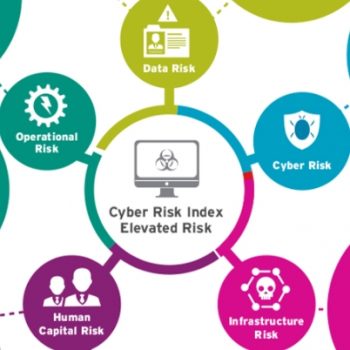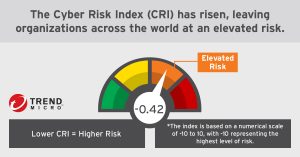
Over 80 percent of all German companies expect their customer data to be stolen in the next year. The Trend Micro Cyber Risk Index shows that companies are exposed to an increased risk of attacks - German companies have the most concerns in a European comparison.
Trend Micro, one of the world's leading providers of cybersecurity solutions, confirms with a new study that the risk of cyberattacks has increased over the past year. For the next 12 months, 83 percent of all German companies assume that they will be affected by data theft. Most of the respondents rate attacks as “somewhat” to “very” likely.
Trend Micro Cyber Risk Index results
The results come from the semi-annual Trend Micro Cyber Risk Index (CRI), which measures the discrepancy between the current security level of companies and the probability of an attack. In the first half of 2021, the independent Ponemon Institute surveyed more than 3.600 companies of all sizes and industries in North America, Europe, Asia-Pacific and Latin America for the CRI.
The Cyber Risk Index is based on a numerical scale from -10 to +10, with -10 being the highest risk level. The current global index is -0,42. Compared to last year there was a slight increase, which means an “increased” risk.
Results for Germany and Europe
The CRI for Europe is -0,22 - this corresponds to an “increased” risk. Compared to the last survey six months ago (-0,13), the CRI has increased slightly. A European comparison shows that Germany, with a value of 0,38 (compared to 1,02 six months ago), has a lower threat level on average. The North America region has the highest risk in a global comparison with -1,27. On average, European companies feel better prepared when it comes to attacks than American companies. Nevertheless, 83 percent of all German companies assume that a cyber attack that also extends to their customer data is “somewhat” to “very” likely. French and British companies feel somewhat better protected than their German neighbors with 78 and 75 percent respectively. In addition to customer data, it is also expected that additional data and so-called “intellectual property” can leak out in the course of a cyber attack.
The main results of the study by Trend Micro
- 83 percent of the German respondents stated that they would be “somewhat” to “very” likely to be affected by serious cyberattacks that affect their customer data in the next 12 months - compared with 86 percent worldwide.
- 13 percent were affected by seven or more cyber attacks that penetrated networks / systems within the last twelve months, compared to 24 percent worldwide.
- 12 percent had seven or more breaches of information assets in the past year, compared to 21 percent globally.
- 28 percent of the German respondents said they had suffered one to six breaches of customer data, 10 percent had more than six attacks targeting their customer data.
“To reduce cyber risk, organizations need to prepare better by focusing on the basics first: identifying the most vulnerable critical data, focusing on the most critical threats to their business, and providing layered protection through well-connected platforms “, Says Richard Werner, Business Consultant at Trend Micro. “It is important to understand that the escalation of the threat level is not a passing wave. The IT security landscape is currently changing significantly due to external factors. What is crucial, however, is the leeway that companies allow for their defense. IT security must be perceived as business-critical. "
Global study results
The companies surveyed around the world named the following cyber risks most frequently:
- Man-in-the-middle attacks
- Ransomware
- Phishing and Social Engineering
- Fileless attacks
- Botnets
Cloud computing is one of the most vulnerable infrastructures. Companies rated it 6,77 points, assigning it an increased risk on the 10-point scale of the index. Many of the respondents stated that they spend “considerable resources” on third party risk management, for example from cloud providers. As was the case six months ago, misalignments in the organizational structure and its complexity are among the most important infrastructure security risks. In addition, respondents cited customer churn, loss of intellectual property, and the disruption or damage to critical infrastructure as the top operational risks facing businesses.
Results help with priorities of the security strategy
"Trend Micro's Cyber Risk Index helps companies better understand their cyber risk," said Dr. Larry Ponemon, CEO of the Ponemon Institute. “Companies around the world can use these results to prioritize their security strategy and focus their resources so that they can best manage their cyber risk. With security incidents increasingly challenging for companies, this type of study is a valuable resource for companies of all sizes and in all industries. "
More at TrendMicro.com
About Trend Micro As one of the world's leading providers of IT security, Trend Micro helps create a secure world for digital data exchange. With over 30 years of security expertise, global threat research, and constant innovation, Trend Micro offers protection for businesses, government agencies, and consumers. Thanks to our XGen™ security strategy, our solutions benefit from a cross-generational combination of defense techniques optimized for leading-edge environments. Networked threat information enables better and faster protection. Optimized for cloud workloads, endpoints, email, the IIoT and networks, our connected solutions provide centralized visibility across the entire enterprise for faster threat detection and response.

